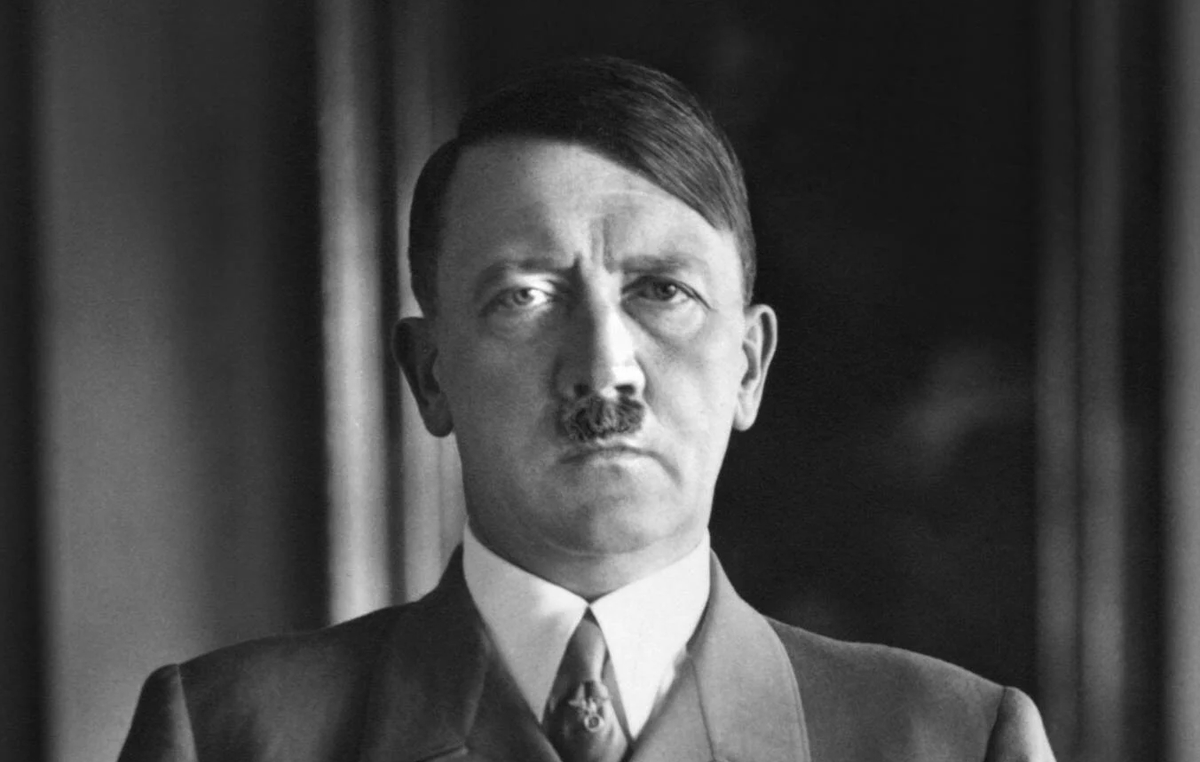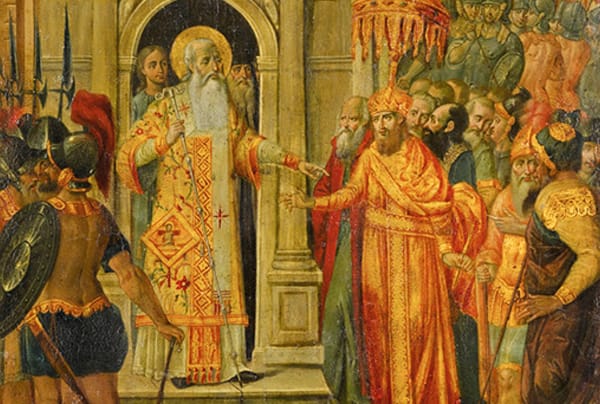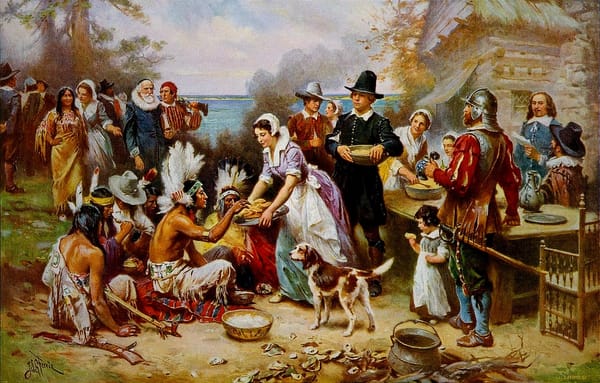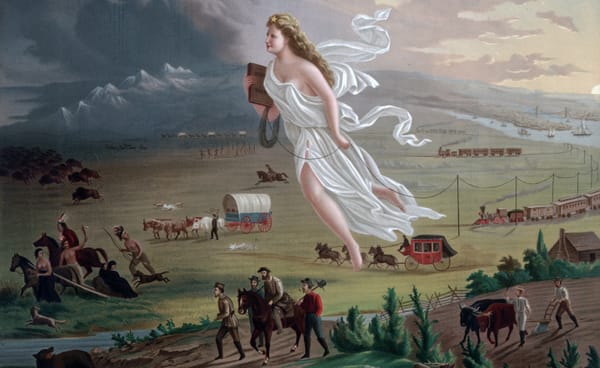The Specter of Hitler and the Right-Wing Counter-Mythology
We cannot adequately address the post-war consensus without addressing its central figure.

Introduction
Within the past year or so it has become fashionable among conservative political commentators to decry the “postwar consensus” (PWC). However, amidst all of the hand-wringing and blame-laying, few have taken the time to precisely define this phrase. Even fewer bother to address the key figure of the PWC—the notorious, mustache-wearing painter from Austria.
Why should Adolf Hitler be addressed, you might ask? Can’t we talk about the deliberately crafted post-WW2 narratives without dealing with such a polarizing figure?
R.R. Reno, author of Return of the Strong Gods, which popularized the phrase “postwar consensus,” describes the foundational narratives that were developed post-WW2:
The anti-fascist consensus after 1945 sought to prevent the return of the strong gods that had fueled the Third Reich and other totalitarian regimes…. Following the end of the war there was a general consensus that nothing like what happened in Nazi Germany must ever be allowed to happen again.
So in essence, the postwar consensus is a collective commitment rooted in post-WW2 liberalism and anti-totalitarian ideologies to prevent the resurgence of the ideologies that fueled the Third Reich and similar regimes.
When discussing the postwar consensus, many commentators stop there, missing a key aspect of this narrative. Reno continues, “The specter of Hitler is a blunt instrument, wielded to enforce conformity to the postwar consensus.” Thus, the narrative surrounding Hitler empowers this consensus and mechanizes cooperation. In an effort to prevent the return of the strong gods of fascism, totalitarianism, and so forth, the postwar consensus characterizes Hitler as the arch villain of history—the embodiment of evil. Even if we accomplish nothing else, this ideology declares, we must prevent the second coming of a Hitler figure.
Dr. Stephen Wolfe, recognized expert on Christian Nationalism, makes this point: “PWC can be summarized as this: Hitler has replaced Jesus as the animating figure of our time. Jesus told us what to love, but now Hitler-hating tells us what to hate. Hate has replaced love. What animates us is only what to hate…. And we’re only allowed to love what we think Hitler would hate…. And we're required to hate whatever we think Hitler would love…. In short, Hitler is the most central figure of our time.”
The Weaponization of the Hitler Mythology
Thus, the mythology surrounding Hitler animates every political discussion, as he has become the standard against which all politicians are measured. Hitler has been transformed into a rhetorical cudgel, wielded to enforce ideological conformity across political discourse. Any actions or statements that even hint at nationalism, pro-natalism, White advocacy, authoritarianism, and so forth, will be condemned as “Nazism” or compared to the Third Reich. Referencing the rubric that Dr. Wolfe previously presented, the logic is as follows: Hitler loved X. We must hate what Hitler loved, therefore we must hate X. In this example, “X” could be the most innocuous thing imaginable, but it makes no difference to the brute, mechanical operation of the postwar consensus.
References and comparisons to Hitler have arrived at such a nonsensical point that the phrase “Literally Hitler” has become a meme. Political figures from Barack Obama to Donald Trump have been compared to Hitler with little factual or historical grounding.

Hyperbolic or absurd comparisons to Hitler led to the development of Godwin’s Law, which states, “As an online discussion grows longer, the probability of a comparison involving Nazis or Hitler approaches one.” The existence of such a principle highlights the pervasiveness and absurdity of the postwar consensus’ weaponization of Hitler in political discussions.
In essence, Adolf Hitler the person has been almost completely divorced from the historical context in which he existed and now lives on only as a symbol. In many ways, the actual facts surrounding Hitler’s life simply no longer matter in the popular discourse. Hitler epitomizes evil, they say, and his memory will be weaponized to force acquiescence to the postwar consensus.
The Right-Wing Counter-Mythology
In response to the PWC’s dominance, there has been an effort among a small, but vocal subset of the Right to develop a counter-mythology to combat the postwar consensus narrative. This isn’t to say that there is a uniform opinion of Hitler on the Right, or that the history of WW2 and the Third Reich is unimportant, but there is a growing sentiment among right-wingers that constantly denouncing Hitler (and trying to differentiate their views from 1940s Germany) is an exercise in futility. No matter how thoroughly they repudiate Hitler and the Nazi party, they’ll always be considered a Nazi by somebody. This sentiment reflects a growing frustration on the Right that engaging with PWC accusations is a losing battle. Instead of endlessly refuting Nazi labels, some right-wing commentators and online communities have sought to neutralize these terms by embracing or redefining them rhetorically.
This posture is based on a refusal to allow scare terms to set the discourse, or to accept the Left’s presuppositions and rhetorical frame. Accusations of “racism,” “sexism,” and “homophobia” are rapidly losing their power. Yet, due to the prevalence of this widespread postwar propaganda, the Hitler and Nazi comparisons still often put right-wingers on the defensive. Hitler is the Left’s rhetorical silver bullet to control discourse, distract from actual issues, and put their opponents into a vulnerable position. Rather than denouncing a long-dead political figure or going point by point through the NSDAP party platform to differentiate themselves from the bad guys, many on the Right have endeavored to normalize these terms in order to neutralize their power. As prolific White Boy Summer advocate Ethan Holden notes, “I have come to learn that ‘Nazi’ means: Anyone who does not decry the Nazis enough.”
If Nazism means loving my people and wanting them to survive, they say, then I’m a Nazi. If a high school football player and his girlfriend “reeks of Nazism,” then maybe Nazism isn’t all that bad.

If Donald Trump, a moderate, is literally Hitler, then maybe Hitler wasn’t a villain on par with Satan himself. Note that, in most cases, this is primarily a rhetorical strategy to gain an advantage in popular discourse. The terms in play have become so devoid of meaning that comparisons to Hitler have almost no relation to the historical figure and accusations of “Nazism” have but tenuous connections to the NSDAP.
At the same time, the Left’s overuse of Hitler analogies has begun to push right-wing Zoomers towards historical research and revisionism. Similar to how COVID propaganda backfired and influenced dissidents to “do their own research,” the almost sacral tone and controlling nature of the postwar consensus has enticed many young men to revisit the history surrounding WW2. As Hitler speeches trend on TikTok, young right-wing men have begun to sympathize with his arguments. When he decries the moral decay, economic profiteering, and eroding national identity of Weimar Germany, young American men begin to wonder if his struggle is their struggle.
Manosphere guru and former Hitler meme aficionado, Will Spencer, recently wrote an article about how young Christian men are rehabilitating Adolf Hitler. Others have similarly emoted about “Hitler worship” or “Nazi obsession,” overstatements designed to mischaracterize and smear this counter-mythology.
While it is true that some have argued that Hitler was a Christian and a model for an ideal political leader, many take a more modest approach. This increasingly prevalent perspective describes Hitler as a relatable anti-hero who may not have been virtuous, but diagnosed genuine societal problems and took it upon himself to do something about it. Hitler’s critiques of Weimar Germany’s moral and economic decline resonate with the experiences of the displaced young men of the West. “Maybe irreversible societal deterioration requires a ruthless, pragmatic backlash,” they wonder. As the next generation watches the so-called “virtuous” men of our day do nothing about the problems we face, they begin to see the utility of an imperfect but bold leader who has the stomach to do what must be done.
Most discussion regarding Hitler’s unique place in history revolves around the Holocaust, which is touted as Hitler’s great evil and is the singular event that separates him from men like Napoleon or Julius Caesar. As the narrative surrounding the Holocaust loses sway, Hitler becomes humanized. This typically takes the shape, either of counter-narratives disputing the veracity of the claims of the Holocaust, or of people echoing the sentiments of Ben Shapiro on another point of history, by saying that they don’t really care whether or not the Holocaust is real, because it happened a long time ago.
Conclusion
In retrospect, it is clear that the Left overplayed their hand. In an effort to prevent the return of the strong gods, they turned Hitler into a caricature and demanded ritual denunciations of him and his works. People are tired, however, of the moral posturing and enforced conformity. While the PWC claims it seeks to prevent the return of totalitarian ideologies, its reductive comparisons have stifled nuanced debate and, ironically, might end up ushering in these strong gods that it so fervently endeavors to prevent.
So how will the Right address the specter of Hitler, particularly as young online right-wingers take an interest in these topics? Will we distance ourselves from any association with Hitler and the Nazi regime and be caught in an endless performative cycle of striving for a reasonable and anti-extremist appearance? Will we embrace these smear tactics and face our detractors head on? Or will we seek to avoid the discussion altogether?
It remains to be seen which strategy will take root and be most effective. But we cannot adequately address the PWC without addressing its central figure. Eventually, as we attempt to tear down the PWC, the Right will be confronted with the specter of Hitler and must be able to give an adequate response.
ATTENTION READER: We need your help.
Institutional trust is at record lows. But without institutions, we cannot renew our people, much less provide an inheritance to posterity. In response to this crisis and as an organic outgrowth both of necessity and natural interest, American Mantle exists, not only as a publication for Protestant, right-wing material, but also as a human project with real-world costs. And so we make our appeal: do you profit from the content? do you want to see more? would you like to support us?
Donate to the Cause. Help us reach our monthly goal in order to solidify this crucial institution.






